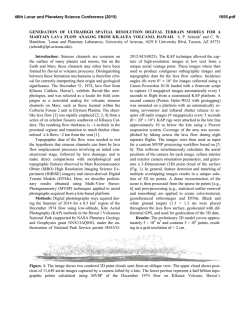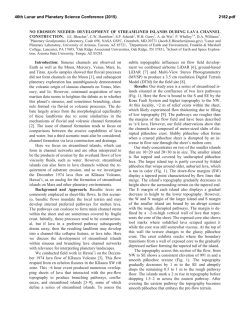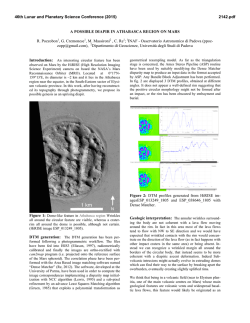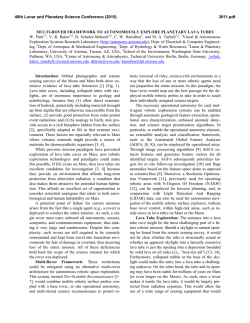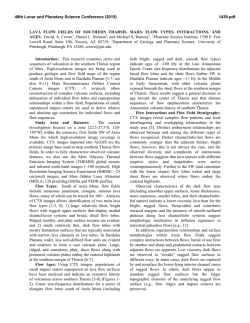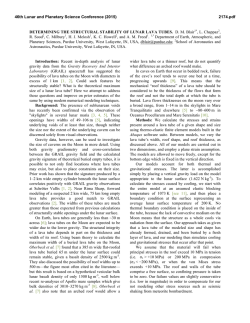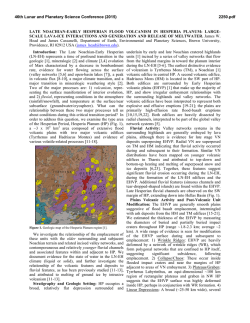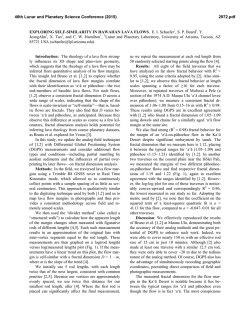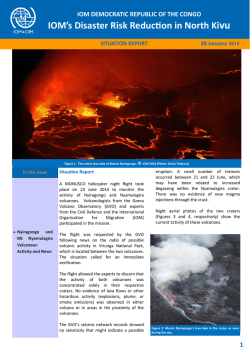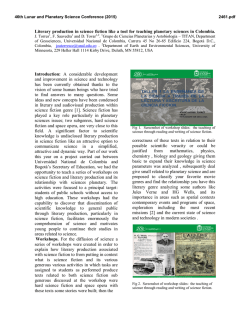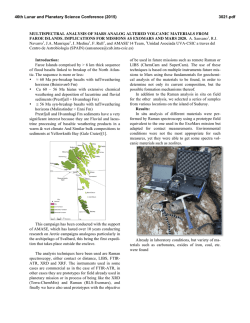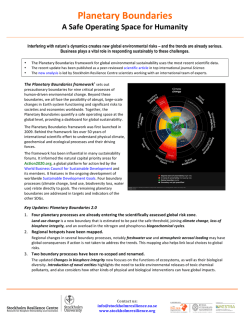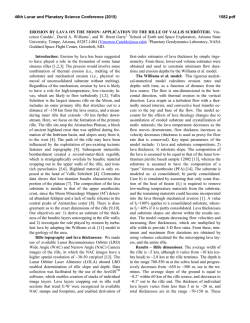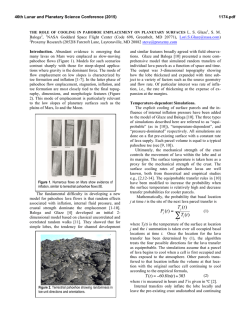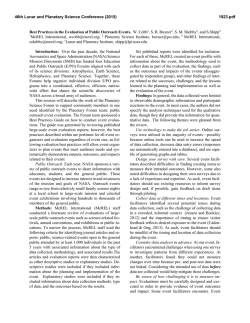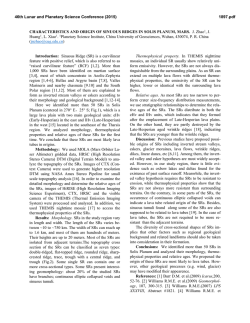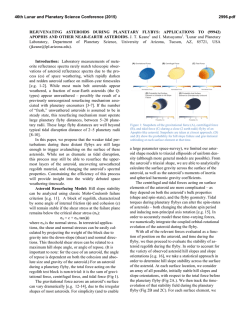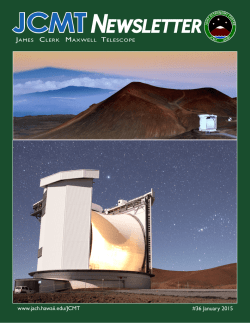
A NEW “PLANETARY VOLCANOLOGY ANALOGS” WEB SITE AT
46th Lunar and Planetary Science Conference (2015) 1203.pdf A NEW “PLANETARY VOLCANOLOGY ANALOGS” WEB SITE AT THE PACIFIC REGIONAL PLANETARY DATA CENTER. Peter Mouginis-Mark1, B. Ray Hawke1 and Ethan Kastner1, 1Hawaii Institute Geophysics and Planetology, University of Hawaii, Honolulu, HI 96822 ([email protected]). Introduction: Landforms in Hawaii have long been used as analogs to aid the interpretation of images of planetary volcanism [1 – 3]. The combination of the easy access to young volcanic features and the abundant remote sensing data that mimic measurements made by instruments on planetary spacecraft make landforms on Kilauea and Mauna Loa volcanoes particularly informative for understanding volcanism on the planets [4]. Indeed, since 1992, we have run 11 NASA field workshops on the Big Island of Hawaii with the specific goal of introducing young planetary researchers to the features and volcanic processes that can be observed in the field [3, 4]. Despite >140 people who have participated in these workshops [3], a limitation has been that not everyone in the community has been able to gain easy access to the accompanying field guides and the field photographs that result from these workshops. To address this limitation the Pacific Regional Planetary Data Center (PRPDC), which is one of the national NASA Regional Planetary Image Facilities, has started a new initiative to make these materials available on line through a Planetary Volcanism Analog (PVA) web site. This abstract introduces the web site content. form. However, at this early stage, we plan the following components: (1) A picture gallery of planetary volcanism images. There are some classic images of volcanic features on the planets (Fig. 1) that have stimulated discussions of volcanic processes operating under different surface gravities, atmospheric pressures, and (potentially) different magma compositions [5 - 7]; Fig. 1: Hadley Rille on the Moon may either be a lava channel or a collapsed lava tube. Fig. 2: An example of the image gallery that will be created, including a location image (top), an air photograph (middle) and a ground photo (bottom). In this example, we see Mauna Ulu, which is a shield volcano that formed between 1969 – 1974 on the East Rift Zone of Kilauea. Note numerous lava channels in the foreground of the air photograph and compare to Fig.1. Web Site Components: The concept for the PVA site [http://www.higp.hawaii.edu/prpdc] is still evolving, and we welcome community input into the final 46th Lunar and Planetary Science Conference (2015) (2) We will create a catalog of field photographs taken by investigators at the University of Hawaii by different themes, e.g., lava shields (Fig. 2), active flows, cinder cones, pit craters and ash deposits. This catalog will include a search capability to show how these features are inter-related in the field, as well as notes on how to access these features in the field; (3) We intend to host field photographs from other investigators. We know of many planetary researchers who perform field work either in Hawaii or visit other volcanoes around the world. We hope that some of these people would be willing to make their images available to the community via our web site; Fig. 3: Multiple remote sensing data sets will be featured on the site, including imaging radar images (top) and hyperspectral thermal data (bottom). These two data sets are fine analogs to, respectively, Magellan radar images of Venus and THEMIS IR data for Mars. Shown here are examples of lava flows on Mauna Loa volcano. (4) We will create a series of short (4 - 5 pages) Planetary Analog Briefs on individual topics, in format similar to that used for the highly successful Planetary Science Research Discoveries (PSRD) web site [http://www.psrd.hawaii.edu/]. One of the main goals of these PSRD-like briefs will be to illustrate how volcanic features in Hawaii have been imaged by different sensors, such as lidars, imaging radars, and hyperspectral thermal cameras (Fig. 3). 1203.pdf The first pair of these Analog Briefs draws together observations of lava channels in Hawaii and examples on the Moon, Mars and Venus, and lava lakes in Hawaii, Io, Mars and Venus. For lava channels, we explore the key concept that the cross-sectional shape of a lava flow with a central channel dynamically changes throughout the eruption. We can see from lava flows in Hawaii that changes in volume flux and blockages in the channel may cause over-spills of lava that mask the width and height of the channel levees. Because these parameters are frequently used by planetary scientists to infer the characteristics of a flow on Mars, the Moon or Venus, the study of terrestrial lava channels helps us understand how well the final morphology of a central channel represents lava flow conditions. For lava lakes, the key concepts are: 1) Much of the surface of an active lava lake may be much cooler than the molten lava a few centimeters beneath this crust. Active lava lakes can show sporadic thermal spikes due to crustal over-turning. 2) The surface of a lava lake can rise and fall, causing disruption to the surface. Solidified lava lakes may have smooth surfaces and lack individual lava flows. Future topics for Analog Briefs will include lava flows, flow lobes, pit craters, skylights, caldera walls, lava shields, dikes, cinder cones, lava tubes, ash deposits, rift zones, ignimbrites, volcano-ice interactions, lava channels, tumuli, lahars, pyroclastic flows, inflated lava flows, and dome. (5) As time permits, we will also include images of non-Hawaiian volcanic analogs on our site, e.g., Iceland and the Andes. These other volcanic regions can provide examples of volcano-ice interactions and explosive volcanism, both of which have importance on the planets are essentially absent in Hawaii. Request for Community Input: Through the new Planetary Volcanism Analogs Site, the PRPDC is striving to provide unique capabilities to the Planetary Community. If you are interested in contributing your field images of planetary volcanic analogs to this collection, please contact the lead author of this abstract. References: [1] Greeley, R. (1974). Hawaiian Planetology Conference, NASA TMX 62362, 257 pp. [2] Carr M. H. and R. Greeley (1980). Volcanic Features of Hawaii. NASA SP-403, 211 pp. [3] Rowland, S. K. et al. (2011). GSA SP. 483, 401 – 434. [4] Mouginis-Mark, P. J. et al. (2011). GSA SP. 483, 435 – 448. [5] Wilson, L. and J. W. Head (1981). JGR 86: 2971 – 3001. [6] Head, J. W. and L. Wilson (1986). JGR 91: 9407 – 9446. Wilson, L. and J. W. Head (1996). Revs. Geophys. 32: 221 – 263.
© Copyright 2024
